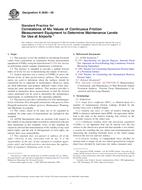Potřebujeme váš souhlas k využití jednotlivých dat, aby se vám mimo jiné mohly ukazovat informace týkající se vašich zájmů. Souhlas udělíte kliknutím na tlačítko „OK“.
ASTM E2666-09
Standard Practice for Correlations of Mu Values of Continuous Friction Measurement Equipment to Determine Maintenance Levels for Use at Airports
Automaticky přeložený název:
Standardní praktiky pro korelace Mu Hodnoty Continuous Friction měřicí zařízení lze zjistit, úrovně údržby pro použití na letištích
NORMA vydána dne 1.8.2009
Informace o normě:
Označení normy: ASTM E2666-09
Poznámka: NEPLATNÁ
Datum vydání normy: 1.8.2009
Kód zboží: NS-45841
Počet stran: 4
Přibližná hmotnost: 12 g (0.03 liber)
Země: Americká technická norma
Kategorie: Technické normy ASTM
Anotace textu normy ASTM E2666-09 :
Keywords:
ICS Number Code 17.040.20 (Properties of surfaces), 93.120 (Construction of airports)
Doplňující informace
| Significance and Use | |||||||||||||||||||||||||||||||||||||||||||
|
Introduction—Mu numbers (friction values) measured by CFME can be used as guidelines for evaluating the surface friction deterioration of runway pavements and for identifying appropriate corrective actions required for safe aircraft operations. The original levels were based on the work of the FAA/AS-90-1 (3). The report states that based on friction values from a Mu Meter Mark II using Dunlop tires, and tests conducted by NASA in the 1970s using a Boeing 727, Table 1 of Mu Meter friction level classifications for runway pavement surfaces was established for friction measurements at test speeds of 65 Km/hr. Additionally, tests were conducted again with the Mu Meter Mark II outfitted with the Dico tire at 95 Km/h. Then a second order correlation was performed for the Mu Meter operating at 95 Km/h and at 65 Km/h resulting in the values shown in Table 2. These values were then fixed and used with correlations of other CFMEs to establish the present maintenance levels given in Table 3.2 of FAA Advisory Circular AC/150/5320-12. From the Wallops 1993 data, the IFI values were calculated and the 65 Km/hr data in Table 2 was used to calculate the FM60 value for each level. The data for the two speeds for the four CFMEs in the FAA report (3) were used to establish the SMp values for each level. Then a new level, New Grooved, was added based on the differences of grooved and un-grooved sites at the NASA Wallops test facility. Table 3 is a list of these values to be the standard values FM60 and SMp for any future calibration of CFME. Airports—Routine testing is carried out in order to obtain data for scheduling remedial work on the runway surface. A single run on either side of the centerline may be regarded as sufficient or a set of runs covering the whole width of the runway may be preferred. At 3m spacing, the friction map which can be prepared from a set of runs of this kind provides excellent information on rubber buildup and surface polishing. Standard test speeds are typically 65 km/hr or 95 km/hr and standard test water film thickness is typically 1 mm. TABLE 1 Original Mu Meter Friction Classifications of Runway Pavement Surfaces for 65 km/hr Test Speed
TABLE 2 Mu Meter Friction Classifications with a Dico Tire of Runway Pavement Surfaces for 65 km/hr and 95 km/hr Test Speed
TABLE 3 Recommended Friction Classification Levels from the Mu Meter for 65 km/hr
|
|||||||||||||||||||||||||||||||||||||||||||
| 1. Scope | |||||||||||||||||||||||||||||||||||||||||||
|
1.1 This practice covers the method of calculating frictional values from correlations of continuous friction measurement equipment (CFME), using the Specification E 1551 tire, for use in performing airport summer maintenance evaluations. 1.2 The practice is intended to provide a unified friction index of levels for use in harmonizing the output of devices. 1.3 Airport operators use a variety of CFMEs to assess the friction levels of their paved runway surfaces. The measurements are used to determine when the surfaces should be considered for or subjected to maintenance. However, many are built differently and produce different values when measuring the same pavement surfaces. This practice provides a method to harmonize these measurements so that the friction values generated can be used to determine the maintenance requirements as established by the operating authority. 1.4 The practice provides correlations for four maintenance levels of friction: New Design/Construction with grooves, New Design/Construction without grooves, Maintenance Planning, and Minimum Acceptable. 1.5 The values stated in SI units are to be regarded as standard. No other units of measurement are included in this standard. 1.6 ASTM International takes no position with respect to the validity of any patent rights asserted in connection with any item mentioned in this standard. Users of this standard are expressly advised that determination of the validity of any such patent rights, and the risk of infringement of such rights, are entirely their own responsibility. 1.7 This standard does not purport to address all of the safety concerns, if any, associated with its use. It is the responsibility of the user of this standard to establish appropriate safety and health practices and determine the applicability of regulatory limitations prior to use. |
|||||||||||||||||||||||||||||||||||||||||||
| 2. Referenced Documents | |||||||||||||||||||||||||||||||||||||||||||
|
|||||||||||||||||||||||||||||||||||||||||||




 Cookies
Cookies
